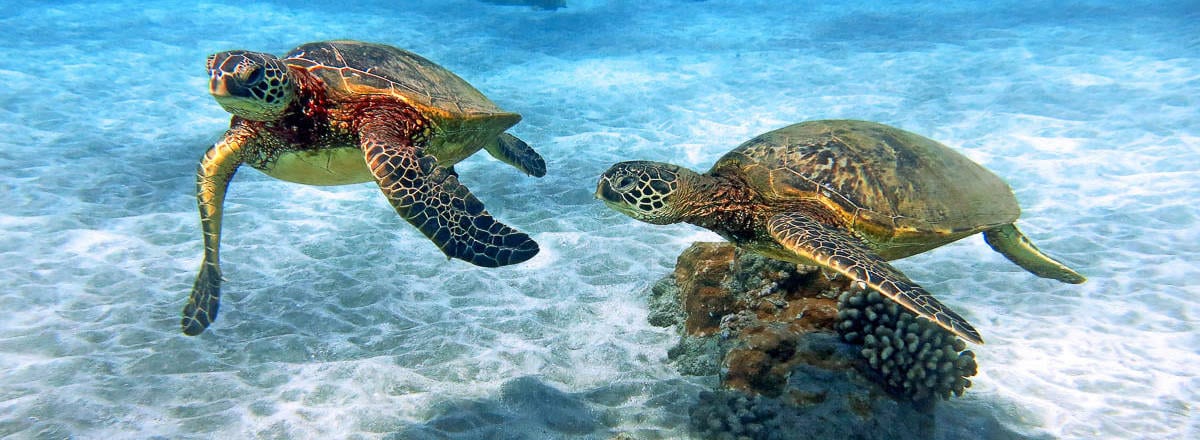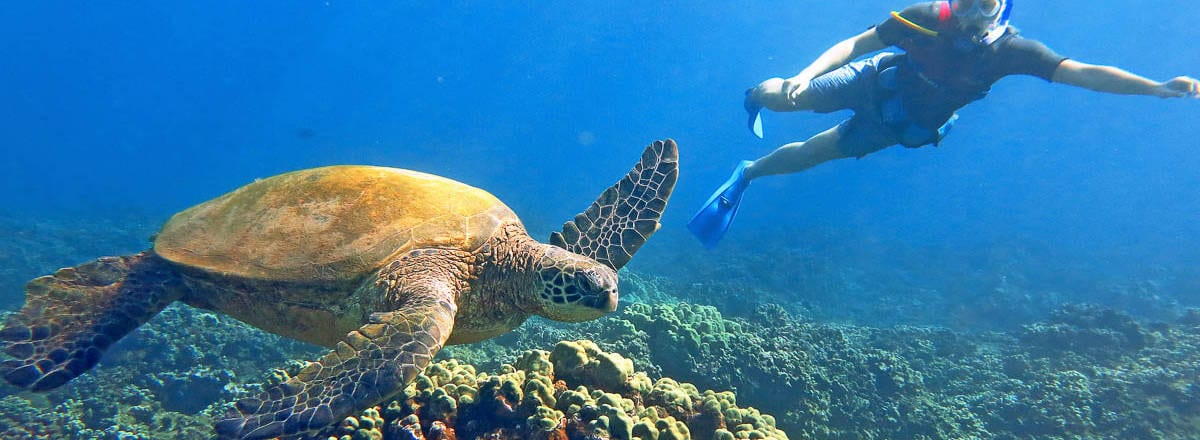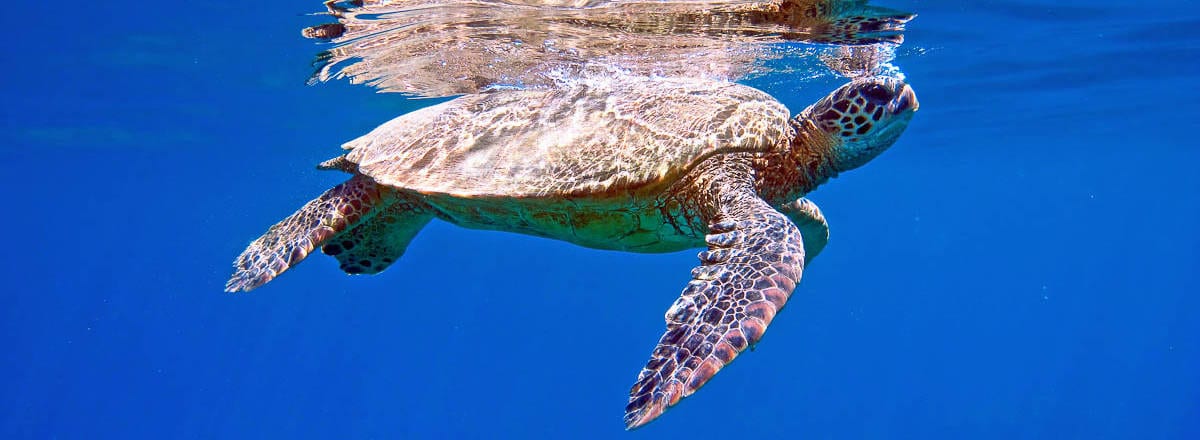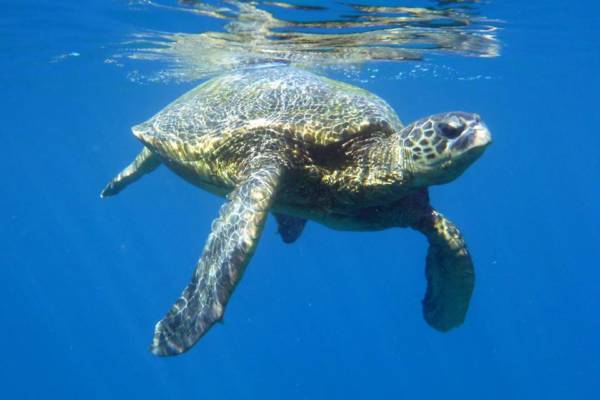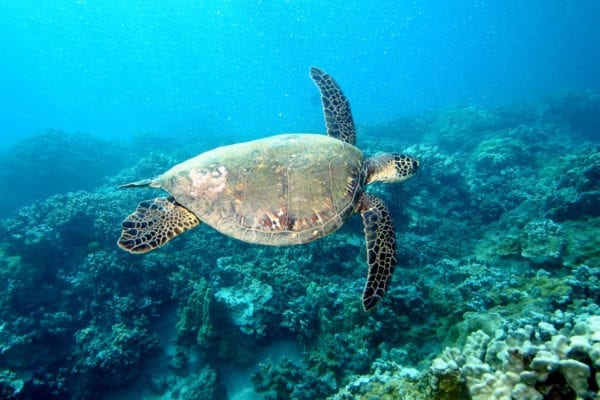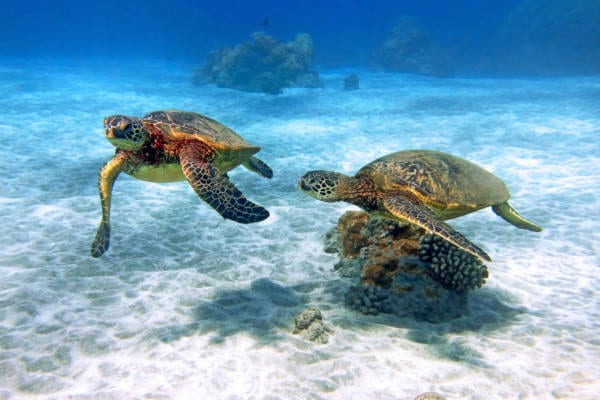Hawaiian Sea Turtle Snorkel
Want to see Hawaii Sea Turtles up close in their natural environment?
Join us for an incredible snorkeling experience at Coral Gardens.
Although we can never guarantee you will see Hawaiian sea turtles, it is quite likely that you will sight them during your snorkel trip to Coral Gardens! Some of the best snorkeling on Maui is at Coral Gardens, which is located just south of Olowalu and fronting the West Maui mountains.
While snorkeling on Maui, you can often spot green sea turtles coming up to the surface to breathe, eating algae off of the rocks or lying on the ocean floor. These majestic creatures are fascinating to watch, but just make sure to remain at least 15 feet away from them and keep your arms by your side. Touching or harassing sea turtles in any way is completely illegal in the state of Hawaii and violators can be fined up to $100,000! Hawaiian green sea turtles are listed as an endangered species and were in steep decline during the 1970s because of the harvesting both turtles and eggs by humans. The population has greatly increased over the last thirty years. Green sea turtles are the most common species of sea turtle found in Hawaiian waters.
Hawaii Sea Turtle Facts
What is a sea turtle cleaning station?
A sea turtle cleaning station is a place where the turtles go and seek out fish to eat the algae off their shells.
What is the best time of day to see turtles in Hawaii?
Sea turtles are often seen on our afternoon Maui Snorkel tour, you can also find them along the beaches of Hawaii and shorelines. Hawaii sea turtles enjoy sunbathing and resting during the daytime hours. The sea turtles often feed on the rocks and coral close to shore.
What do sea turtles eat in Hawaii?
Hawaii sea turtles eat seaweed and algae that grow on the lava rocks
When do sea turtles hatch in Hawaii?
There is no specific season, but a female when nesting will come ashore and lay eggs every 15 days. It then takes 6-9 weeks for the eggs to hatch.
While snorkeling at Coral Gardens (one of Maui’s top snorkeling destinations), we often get the chance to see Hawaiian green sea turtles resting on the ocean floor, eating algae and sea grasses, or visiting their local turtle ‘cleaning station’.
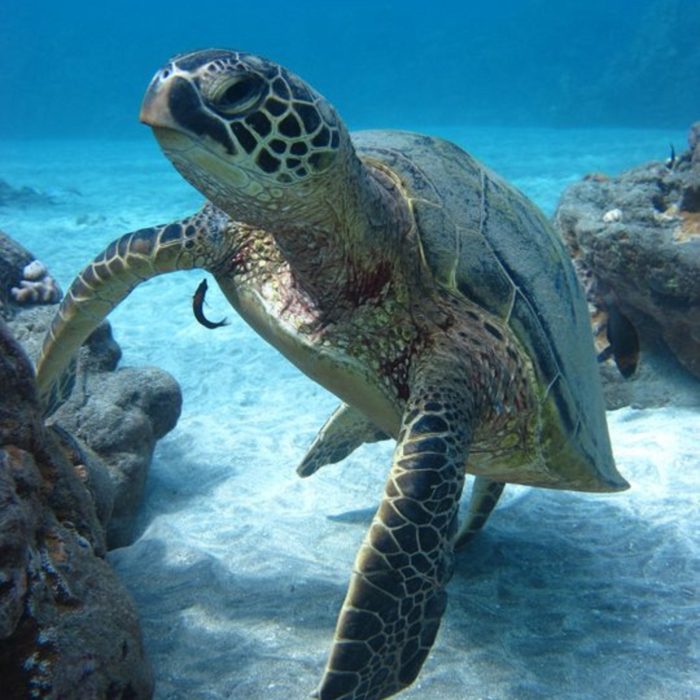
Interesting Facts About Hawaiian Green Sea Turtles
Hawaii’s green sea turtle’s habitat is split between the ocean and land. On Maui, the Hawaiian sea turtle nests and lays their eggs, while they spend most of the time in the ocean.
A Hawaiian sea turtle has an approximate lifespan of 80-100 years. The sexual maturity of a sea turtle is 25-40 years old. An adult sea turtle can weigh up to 700 lbs.
The shell of a sea turtle is called the ‘carapace’ and the underneath portion of the shell is called the ‘plastron’.
Turtle in Hawaiian is honu and gets its name from the color of its skin (rather the color of their body fat).
It is estimated that only 1 out of every 5,000 hatchlings reach adulthood. Females lay their eggs on the beach.
Turtles’ main predators are sharks, especially tiger sharks. Humans also play a role in the decreasing number of turtles, due to entanglement in fishing line, ingesting plastic, poaching, and ocean pollution.
Hawaiian turtles are typically found in warm subtropical and tropical ocean waters and have been observed nesting in over 80 different countries. In the U.S., can find sea turtles in Hawaii, the Virgin Islands, Puerto Rico, and even Florida (east coast).
The Hawaiians consider the honu to be a family guardian (aumakua).
Swimming with Hawaii Sea Turtles
Swimming with sea turtles on Maui is legal but remember to keep your arms at your side and stay a minimum of 15 feet away. Swimming too close to sea turtles can cause them great stress. Please do not touch or feed the sea turtles, rather observe them in their natural environment.
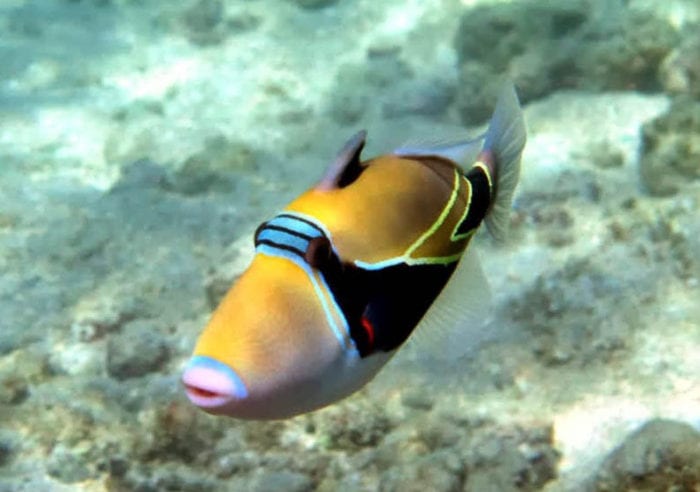
See Hawaii’s wildlife and turtles on our afternoon tour
Hawaii sea turtles are often seen on our afternoon snorkel tours, along with tropical fish and occasional manta rays. One fish we see quite often is the humuhumunukunukuapua’a (reef triggerfish). The humu humu is the Hawaiian state fish.
During whale season you can also join us for a chance to see humpback whales while onboard our tours.
Sea Turtles Make Hawaii Their Home
Sea turtles are graceful saltwater reptiles, well adapted to life in their marine world. With streamlined bodies and flipper-like limbs, they are able to swim long distances in a relatively short time. When they are active, sea turtles must swim to the ocean surface to breathe every few minutes. When they are resting, they can remain underwater for as long as 2 1/2 hours without breathing.
Green turtles often rest in caves or under ledges in deep water. Although sea turtles live most of their lives in the ocean, adult females must return to land in order to lay their eggs. Scientists believe that nesting female turtles return to the same beach on which they were born. Often, sea turtles must travel long distances from their feeding grounds to their nesting beaches. Just how sea turtles find their nesting beaches is unknown. Hawaii’s green turtles migrate up to 800 miles from their feeding areas near the coast of the main islands to nesting beaches in the Northwestern Hawaiian Islands. The males accompany the females in this migration and mate with them offshore from the nesting beaches. After depositing about 100 eggs, the female covers the nest with sand and returns to the sea, leaving the eggs to incubate during the next two months. After hatching, the tiny, one-ounce turtles take several days to emerge from their nest. Once out of the nest, the hatchlings race to the water and swim constantly for the next 36 to 48 hours. While in the open ocean, young green turtles are carnivorous and feed on invertebrates such as jellyfish.
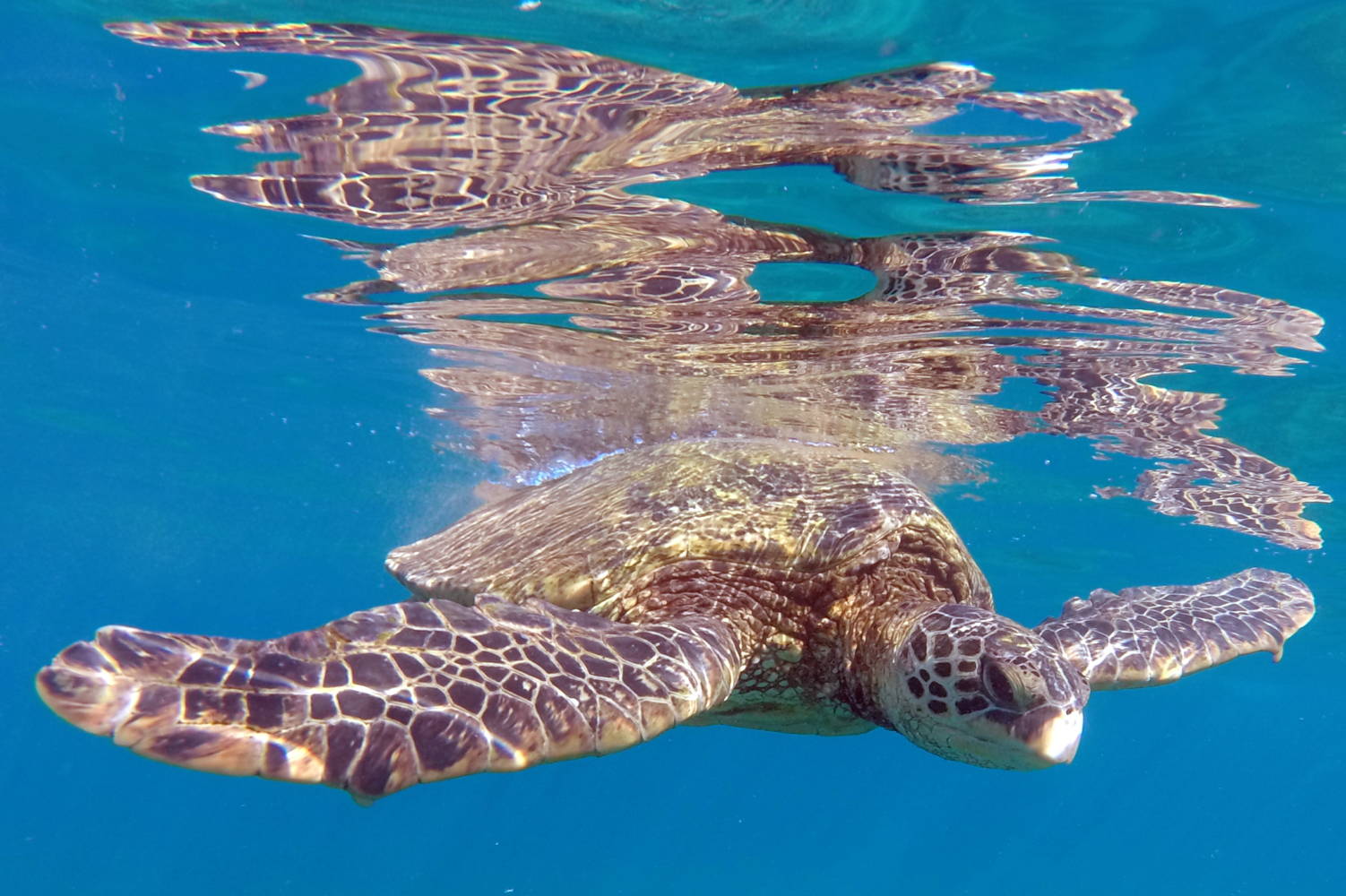
The life span of sea turtles is unknown. Hawaiian green turtles seem to grow very slowly in the wild and may take 10 to 50 years (average 25 years) to reach sexual maturity. Male and female green turtles look alike until they are mature. Then, the male develops a long tail extending beyond the hind flippers. A female’s tail extends only a short distance beyond the end of her shell.
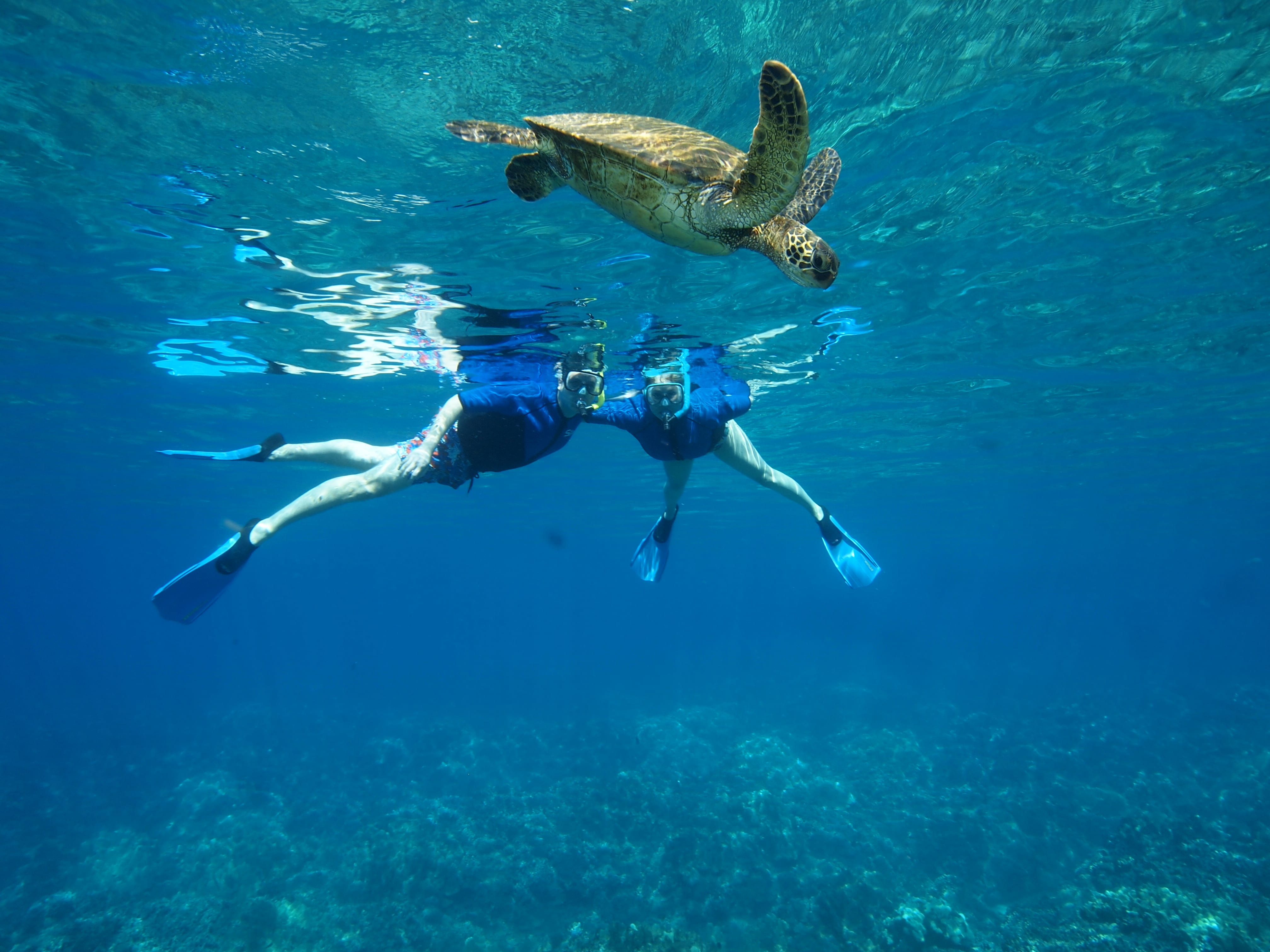
Rescue & Recovery Team
In Hawaii, the green turtle is a threatened species. Only 100 to 350 females nest each year, principally at French Frigate Shoals in the Northwestern Hawaiian Islands. To help restore Hawaii’s sea turtles to their former abundance, the National Marine Fisheries Service, the U.S. Fish and Wildlife Service, and the State of Hawaii’s Department of Land & Natural Resources have formed a Recovery Team. This team will identify research, management, and enforcement needs and will promote conservation through public education programs. All sea turtles in Hawaii are fully protected under state law and under the federal Endangered Species Act. These laws prohibit harassing, harming, killing, or keeping sea turtles in captivity without a permit allowing these activities for research or educational purposes. Divers should be aware that riding turtles is illegal and puts these animals under stress.
The sea turtles are federally protected. Getting too close to them could result in a Federal or State violation. “NOAA and DLNR recommend, for your safety and the animals’ protection, that everyone stay at least 10 feet (3 meters) from all sea turtles. If maintaining this distance isn’t possible, keep safety in mind and move away from the animal as carefully as possible, avoiding sudden movements and other actions that might disturb the animal.” For more information, please visit the Department of Land and Resources website at: http://dlnr.hawaii.gov/dar/species/sea-turtles/.

